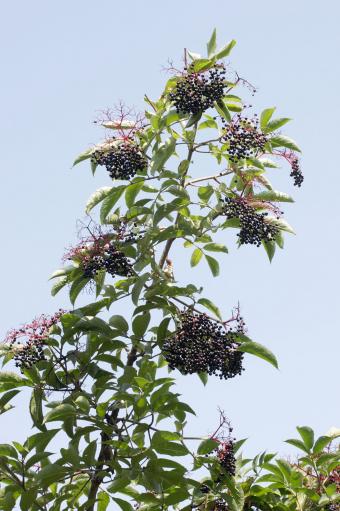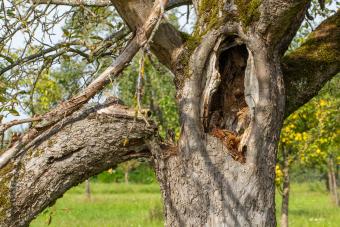
Known for its highly versatile berries, the Elder tree has legions of fans the world over. In addition to being prized among herbalists and chefs, who are endeared to the tree's fruit, the Elder is also popular among landscapers. The tree's shrub-like shape makes it easy to prune and cultivate. What's more, the pretty blossoms and gorgeous green leaves bring beauty and elegance to yards and parks.
Appearance of the Tree
The Elder tree can grow up to 30 feet tall though most types average a manageable height of 15 feet.
While the tree is by no means gigantic, it does possess a number of unique characteristics, including:
- Leaves: The Elder leaf is a compound with five to seven leaflets attached to each twig. Individual leaflets are longer than they are wide, and each feature serrated edges and small hairs which grow on the underside.

- Flowers: The pleasant-smelling flowers appear in large clusters during the spring. The tiny blooms are white or cream colored and quite delicate.

- Fruit: The tree's fruit are called elderberries. The small orbs range in color depending on the type of tree. The most common colors are black, dark blue, dark purple and red. Each berry grows to a maximum of ¼-inch in diameter.

Elder trees also have distinctive looking bark. While it starts off brown and smooth, as the tree ages, the bark becomes dark brown, rough and furrowed.
Elder Tree Types
There are several dozen species of Elder trees, which grow around the world; however, some are better received than others. Among the most popular types of Elder trees are:
- European Elder: Also called "Black Elder," the tree produces fruit that is coveted by herbalists for medicinal purposes. The tree is also the tallest of the Elders soaring to heights of 30 feet. The tree's berries start off green, then turn red before evolving to black which indicates that they are ripe and ready to be picked. The berries are poisonous in their raw state though when cooked they offer an array of medicinal benefits.

- American Elder: This species is native to North America with large growth populations occurring east of the Rocky Mountains. The American Elder grows to about 10 feet high and is used as a border or ornamental tree. Homeowners throughout the United States use the tree as a hedge for driveways or sidewalks. It too produces white flowers and dark purple to black berries.
- Blue Elder: The tree is known for its large, drooping clusters of dark blue berries which are harvested in late autumn. Depending on the growing conditions, a glaucous sheen forms on the surface of the berries giving them a cobalt blue appearance.
The Many Looks of the Elder Tree






Where the Elder Grows
Elder trees exist throughout the world including:
- North Africa
- Asia
- Austria
- France
- Germany
- Norway
- Scandinavia
- England
- North America
The tree thrives when it is cultivated in moist, well-fertilized soil and in full sunlight. In addition, Elders need the pH of the soil in which they are planted to be neutral or moderately acidic. More importantly, though, the tree needs access to plenty of water. The Elder tends to grow in places where it gets watered regularly, such as sides of mountains or valleys where rain pools.

Popular Uses
By far the most popular use for Elder flowers are also used externally to treat:
- Rashes
- Dry skin
- Sunburn
- Acne
- Eczema
- Psoriasis
In the culinary world, ripe elderberries and flower extracts are used to create:
- Pies
- Tea
- Jam
- Sauces
- Syrup
- Soup
- Wine
- Juice
- Muffins
- Bread
The dark berries can only be consumed when they are ripe and cooked. Raw, unripe berries are toxic and should be avoided.

Interesting Facts
Fans of Harry Potter may remember a reference to the tree in the popular series of books. The most powerful wand in the land was made of Elder tree wood and featured a core of Thestral tail hair. It is also known as the "Deathstick" and the "Wand of Destiny."
Long before the birth of Harry Potter, the Elder tree was used by other cultures for a variety of purposes, such as:
- Ancient Greeks used the tree's roots as a laxative.
- In Biblical times, Judas was thought to have hanged himself from an Elder tree.
- During the Middle Ages the Elder tree was thought to house witches and cutting it down would bring bad luck.
- Shakespeare referred to the Elder tree as a "symbol of grief."
- In Russia, it is considered good luck to plant an Elder tree near your home as it wards off snakes.

Elder Diseases
Elder trees are inherently weak. Their wood is apt to split and is not used to create large scale items. Consequently, the tree is susceptible to a number of diseases, including:
- Verticillium Wilt: This fungal disease causes leaf curling and drying. It can also result in abnormal yellow discoloration and premature leaf drop. Acute cases can kill the tree.
- Cankers: These unsightly sores attack the trunk of the tree and can spread to the branches. In serious cases, the cankers ooze and can infect the roots of the tree.
- Powdery Mildew: This common fungus-related disease produces a white powder that covers the tree's leaves. Once the fungus has set in, the leaves become disfigured and yellow specks begin to form. Fortunately, the disease can be cured by removing the infected areas.
In the summer, Elder trees are also preyed upon by Box Elder bugs which feed on the leaves and flowers.
Elder Care
Elder trees need a lot of water in order to thrive. If you live in a temperate environment which gets a good dousing of rain on a regular basis, then you might consider adding an Elder tree to your property. By having nature water your tree, you will have little maintenance to complete in the cultivation of the tree.
Other ways to keep your Elder healthy include:
- Do not fertilize the tree. The low-maintenance tree does not require commercial fertilizer if planted in well-drained soil.
- Do not plant an Elder tree in the shade of a taller specimen or a large building.
- The tree needs full sunlight to grow.
- Do not plant Elder trees near a children's play area. Since the tree's berries are toxic when eaten raw, you don't want to tempt kids who don't know better.
- Pruning should take place in late summer. Prune more if you want to keep the tree from growing to a height that is unmanageable for you.

Versatile Elder Tree
The elder tree is very versatile for landscaping as well as providing flowers and berries for culinary uses. Elderberry wine, flower extracts and flower essences are long-time remedies in folk art and homeopathy medicines.







